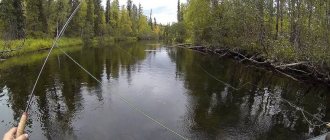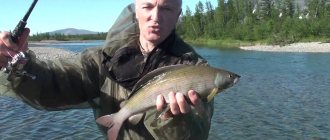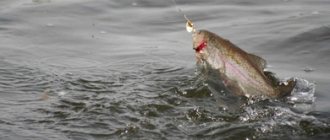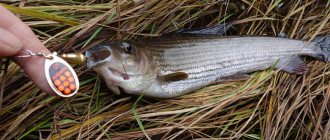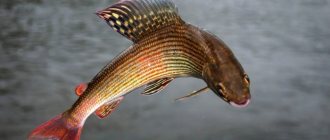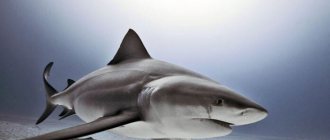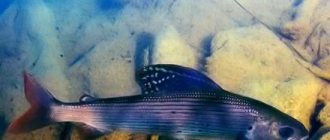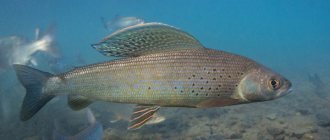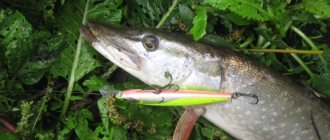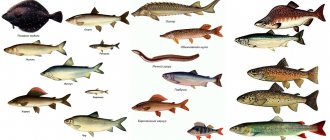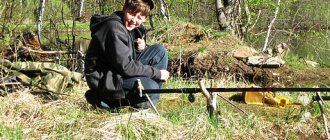Grayling, a close relative of salmon and whitefish, lives only in the Northern Hemisphere. Its habitat is the clean and cold waters of rivers and lakes with a rocky bottom. In Karelia, grayling is found in almost all rivers and in the cleanest and rockiest areas of Lake Onega. Grayling differs from other fish species by its large dorsal fin decorated with spots or stripes. Grayling also has a small adipose fin on its back, indicating the nobility of this fish and its connection with salmonids. Graylings can reach a weight of 2.0 – 2.5 kg. Typically, catches are dominated by individuals weighing 300–600 grams, but specimens weighing 800–1000 grams are not uncommon. The food supply of grayling includes crustaceans, mollusks, larvae, mayflies, caddis flies, as well as various insects that accidentally fall into the water. Although the grayling's main food supply is insects, crustaceans and mollusks, it will not refuse caviar and small fish. Grayling leads a sedentary lifestyle, but with the onset of consistently hot weather, when the water warms up very much. At this time, he leaves his homes for colder water or deeper water. In Lake Onega, grayling should be looked for on rocky shallows with depths of no more than 1-3 m, as well as in the surf with a rocky shore, where it is attracted by the abundance of crustaceans, caddis flies and various insects washed out from under the stones.
Fishing for grayling using a spinning rod
Spinning rod for grayling fishing should have a test of 0-5g. (ultra light), everyone chooses the length of the spinning rod themselves. A non-energy reel with a wound fishing line with a diameter of 0.2 - 0.25 mm is installed on the rod. As bait you need to have a whole arsenal of spinners and small wobblers. To catch grayling, you can use “Mepps” spinners with numbers from 0 to 3, petal colors: black, black with orange dots, silver, copper. Having a fly on the tee is not necessary, but sometimes it helps to catch a neighbor. You can also use wobblers from 1 to 3 cm long with natural colors.
Lure for catching grayling
As the fishermen managed to notice, the bait must be applied directly to the grayling, since it pays little attention to prey away from itself. Therefore, the fisherman must cast the bait with utmost precision. It is advisable to move the lure slowly, because grayling bites on such “prey” much more readily. It is necessary to select a spinner taking into account this particular feature.
If you want to catch grayling weighing up to a kilogram, you will need a rod up to two meters long. The most successful spinners are those that do not exceed 2-5 centimeters in length and do not exceed a weight of 1-6 grams. The "spinning blade" is the most popular type, but when catching big fish, several small oscillating spoons will come in handy. The fishing line should have a diameter of 0.2-0.25 millimeters; it should be increased only when hunting heavier fish.
Grayling can be caught five meters from the shore if the depth in this place is shallow. A large cast is useful if such a place is located 20-30 meters from the parking lot.
Fly fishing for grayling in Karelia
Fly fishing was not originally intended for catching fish in calm water, but with the right selection of rods and cord, this is also possible on Lake Onega. For fly fishing for grayling in Karelia on Lake Onega, you will need a class 7 rod, reel and line, and a leader of 0.14. Also, it is necessary to remember that in case of strong excitement this method will not work. Each weather has its own fly colors and therefore everything is selected empirically. It’s not uncommon to catch bream and perch using fly fishing on Onega.
Fishing for grayling in Karelia
Karelian grayling is no different from its counterparts in reservoirs of other regions. Here he also prefers to live in clean and cold water, choosing areas with rocky days. It is most often caught in rivers, but it is also found in lakes. But the lake should have clear water, and you should look for grayling in areas with a rocky bottom. And there are many such lakes in Karelia, but we will talk about fishing places below.
Grayling is a cautious fish, so when catching it, do not forget about camouflage and safety precautions. It is good to catch it in cloudy weather in the evening and morning - in such conditions it becomes less careful and can come straight to the shore.
Most often they catch it by fly fishing, using the bait that can be found locally. However, artificial bait also gives good results. Grayling is also caught in Karelia using a spinning rod and a float rod. Small spoons are used.
As we wrote above, in lakes it is worth looking for areas with a rocky bottom, and in rivers grayling prefers to stay in places with a smooth current. Places where trees or bushes hang over the water are especially good - there will almost certainly be grayling that hunt insects falling into the water.
Small grayling can be caught in areas with fast currents (even on riffles), but large ones will still stick to places with slow currents. Large individuals like to “inhabit” a certain area; it’s good if there are snags, drowned trees, and large underwater rocks.
It does not like thickets of underwater vegetation, although sometimes it can be caught there, but in general, you should not count on it.
Catching grayling with spinning or fly fishing
The method of catching grayling with a spinning rod using a light fly is quite possible. To do this, you need a spinning rod with a large dough of 10-30 g. and accordingly, you should use braid with a diameter of 0.15 or fishing line, but with a larger dough. Naturally, it is almost impossible to cast a light fly, and even with a thick thread. To do this, you need to equip the tackle with a liquid float or sbirulino with a special leash. By filling the float with water, you can easily adjust the depth of the fly when retrieving it or even make it play on the surface of the water, and its weight will help you cast the bait over a decent distance.
In summer, grayling, as a rule, does not lack food. Therefore, it can be very difficult to seduce him into artificial bait. The success of fishing largely depends on the correct selection of flies in size and color. The best information on this matter can be obtained by opening the stomach of a caught grayling and finding out which insects the fish currently prefers. In certain periods, even large individuals can feed exclusively on small midges, ignoring other insects. Grayling is most often caught using flies with bellies in brown, red, dark gray and olive tones. Grayling is especially partial to the red color, so it’s better to start fishing with a red fly.
If the grayling does not pay enough attention to your fly and is reluctant to take it, you can try changing the tackle and catching it with a spoon or fishing rod.
The bite on these baits is better in late summer and autumn. The grayling has its own grip on the spoon; having swallowed the bait, it begins to rush from side to side, and when a few meters remain from the boat, it rises to the top and begins to dance along the surface. When fishing for grayling, it is necessary to have a landing net, because Grayling has extremely weak lips and therefore it should be fished out carefully, without forcing it, and at the boat it should be carefully brought into the landing net. How to get there Prices Contacts
Grayling fishing in Karelia
Grayling is found in the Karelian lakes Onega, Topozero, Pyaozero, Segozero... we caught them with a spoon and a worm, and caught fish per kilogram.
In fast-flowing rivers with holes, riffles and rapids, such as Olanga, Kepa, Vodla, Kurzhma, Tumcha, Voinitsa, Pista... and in their tributaries, smaller grayling are caught. There are many river sailfish in the rivers of Paanajärvi National Park. Karelian grayling belongs to the European group; it has a small mouth with weak and inconspicuous teeth. The group of Siberian graylings has a noticeably larger mouth, as well as teeth; there is also the Baikal grayling. Amazingly beautiful fish, a living piece of silver with different colors and shapes of its famous fin - the sail. Grayling is not a large fish, up to 1.5 kg and more often 150-500 g. In the south of Karelia there are few rivers where grayling is found; the main grayling lakes, rivers and streams are located in the north of the republic. Grayling is caught from the end of the spawning ban until sludge appears on the rivers. Spawning for this fish usually occurs in May - early June and most often occurs on small river riffles. Grayling feeds mostly on insects and worms washed into the water, as well as various bottom insects, since its small mouth does not allow it to catch large prey. Large grayling will not miss the fry. Grayling is caught by fly fishing, spinning rod, “boat” and float rod. Before choosing your final fishing spot, be sure to ask whether fishing is allowed there; some of our rivers are completely closed to fishing (even fishing rods are not allowed). And if you decide to just relax there, a visit to your fish camp by an inspector will be inevitable (not the most pleasant thing!). I highly recommend that you read the changes to the “Recreational Fishing Rules” for northern Russia. In addition, grayling is a very cautious fish, and all accessible rivers are very visited by tourists and fishermen, so you shouldn’t count on a stable bite here. The best places are located far away from highways, where the water is ankle-deep in the river, where very significant specimens are found. Only true fans of such extreme grayling fishing can get there, but if you decide to do this kind of fishing, read a few tips. Include in your equipment a mosquito suit, special gloves, and buy allergy medications. The number of mosquitoes and midges in our forests is huge, and neither sprays nor ointments can save you from midges. Walk very carefully on moss-covered boulders; moss that is wet on the inside can simply come off, and bruises and fractures are inevitable. Wading boots should have spikes; falling on slippery rocks can also lead to fractures. This is a wild forest and you can find a bear in it, and in the north of the republic you can also find a wolverine. To prevent these uninvited guests from coming to your camp, do not throw fish and other cleaning products next to it. When walking through the forest and in parking lots, try to make as much noise as possible; in summer and autumn, bears are well-fed and won’t just attack, but if you meet him unexpectedly, you won’t be able to escape. Unfortunately, such cases have already happened. Summer
All types of grayling prefer a rocky bottom, drains in front of rapids, riffles, shallow areas of reaches closer to drains... and cold water! Large graylings stand in areas with great depth where there are large boulders, flooded trees, and other shelters, from where, without spending much effort, he can control his zone, which he knows well. Grayling avoids very strong currents and places overgrown with underwater grasses. But sometimes it still visits grassy places, more often this happens at the time the caddis fly emerges, usually at the end of May-June, which grayling loves very much. Grayling is caught at this time by fishing with Shitika. It can stand in the water under the shore, from where larvae and other living creatures crawling on stones enter the water. Finding a grayling site in summer is not a problem. In good clear weather, he himself will show where to catch insects by going out for insects. Unlike other fish, graylings often jump out of the water, grabbing insects in flight. Grayling is capricious and unpredictable, and sometimes it is extremely difficult to find bait for it. It all depends on the experience of the fisherman himself and the successful selection of bait. To do this, it is advisable to catch at least one fish and see what it eats; the bait is selected accordingly. When butterflies and flies appear above the water, it is time for fly fishing. With this kind of fishing and a properly selected fly, as well as good camouflage, you can count on a good catch. It has been noticed that in our rivers the most effective flies are olive-gray, but naturally, given the caution of grayling, it should completely imitate a real fly. Although when fishing with such flies the gatherings are very frequent, the fast grayling, realizing that it is inedible, immediately spits it out. With natural baits this happens much less often. This fish’s mouth is weak, so you can’t force the fish to fish, but at the same time you can’t give in any slack. In summer you can fish well with an earthworm or subleaf. They fish from the shore using a regular float tackle, or on a riffle, floating a worm or fly downstream. The best time for catching grayling in the summer is evening and morning, and on white nights with a slight breeze, grayling feeds with short breaks and is caught almost all night.
Autumn
Late summer and early autumn are the best times to catch grayling. Since this is a cold-loving fish, a decrease in water temperature stimulates its appetite, and there are almost no flying insects. Grayling is still interested in flies and rises to the surface after them, but there are no more stormy summer outings. Although in warm sunny weather and in the absence of wind, characteristic circles can still be observed. This usually happens from ten o'clock until the evening. Not only “dry” flies, but also “wet” flies are used, and the fly moving in the water column should not just drag, but behave like a natural insect. At the same time, the water becomes more transparent and the grayling is extremely cautious, so camouflage becomes even more important than in summer. At this time, you can fish well with spinning rods on Meps and Bluefox spinners (0-1). Grayling is still caught using worms and insect larvae. Fishing in autumn is usually carried out in deep places. In the fall, the fish begin to go to their winter stopping places along the way, continuing to feed. Lake grayling that has not “rolled down” after spawning goes into the lakes, while river grayling goes to deeper and wider places in the rivers where it is caught. This process apparently continues until sludge appears on the rivers. In autumn, until the very frosts, grayling is caught on small nymphs - imitations of various types of mayflies. Grayling is a neat and careful fish, so the gear must match it. The fishing line for a float fishing rod is best monofilament (0.20 - O.25 mm) with a long fluorocarbon leash; the hooks must be extremely sharp and the size corresponding to the nozzle. The float should be invisible, as when fishing for trout.
Grayling fishing
Grayling fishing Graylings are sharp-eyed and very cautious fish.
When they see a person, they rush in different directions and, despite being sedentary, never appear in that place again. Due to such features, you need to select fishing rods of inconspicuous colors for fishing and be extremely careful yourself. The best bite occurs in the morning and evening hours; during the day it is inconsistent and rather sluggish. The exception is cloudy days, when a light wind forms small ripples on the surface of the water. On such days, grayling is less careful and takes bait floating not only on top, but also in the middle layers of the water.
In spring, bark beetles and mobile, live worms are good baits. Large graylings often stay alone, and small ones in small schools. At the beginning of summer, the best bait is shitik; in summer - all kinds of insects, preferably the caddis butterfly (shitika). In autumn, in September and November, grayling is especially bold and voracious, and is caught using a moving worm and minnow. The most sporting way of catching grayling is fly fishing, but with the advent of reel fishing, especially spinning reels, it is being replaced by wiring. Fishing in a retrieve with a long release of the float begins from the time of a fairly noticeable drop in the flood level, clarification of the water and until the appearance of aerial insects. It is more successful on bark beetles, worms and shitica. This fishing ends with the beginning of freeze-up. In autumn, the bite is best around noon and in the evening twilight. With the appearance of sludge, grayling slides downstream into the deep sections of the river.
It is possible to catch grayling from the ice in winter. It does not stop feeding in winter. But with the beginning of trout spawning, grayling does not take bait, feeding on its eggs. It can be caught from the ice using small spoons and jigs. The best spinner is narrow, up to 50 mm long, one side is silver, the other is made of red copper. The inner side must be brought to a matte shine. Fish often disappear from a single hook; it is better to hang a double hook No. 5–6 and disguise it with gray feathers, or even better, bait it with a piece of worm. The tactics for catching grayling in winter using lures are no different from catching trout; the pace of trolling is the same as for perch. After catching one, or less often two, grayling, you should not wait for bites in the same place - the fish are scared.
Just like when fishing for trout, the angler does not stay in one place for long; he constantly moves downstream, fishing every suitable place. You should not move upstream - frightened grayling, like trout, always rushes upstream and alerts others here. Caution, camouflage and keeping quiet movements when fishing for grayling are needed no less than when fishing for trout. Frequent casting alarms grayling even more than trout. You need accuracy on the first cast, on the first retrieve. As a last resort, if a hidden approach is impossible, you need to go up and lie down, hide for 5-10 minutes, and then cast the tackle. Grayling is also caught using bottom fishing (on large rivers), spinning rods and boats (on lakes).
When fishing on top, seasonal alternation of insects is used: they try to catch those that are currently flying over the reservoir. In the spring - stoneflies and caddisflies, in the summer - mayflies, botflies and butterflies, and then - grasshoppers. Fishing with artificial flies is only possible in fast currents and during ripples in the water. In calm weather and at depths, it is better to fish with natural insects. The grayling bite is lightning fast and sharp, but it can sense deception and quickly spit out the bait, so the hook should be immediate after the bite. Grayling's lips are weak; it must be fished out smoothly, using the bend of the rod. The gear is the same as for trout, but the hooks are smaller - No. 4–5. When taken out of the water, grayling quickly falls asleep and deteriorates faster than trout in hot weather. Fish caught in the summer must be immediately gutted, the gills removed and placed in a bag, covered with nettles or bird cherry. The smell of freshly caught grayling is characteristic - it smells like a young, fresh cucumber. Grayling meat has no bones. Its taste is cancelled, it is especially good in a pie.
